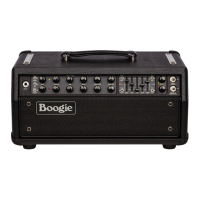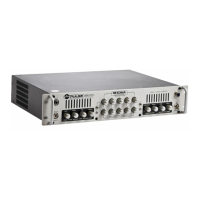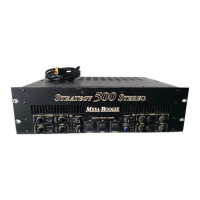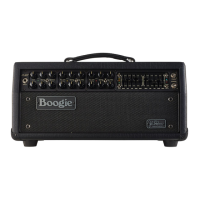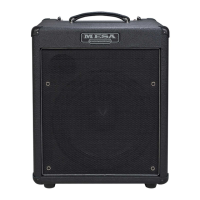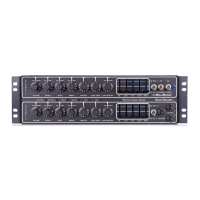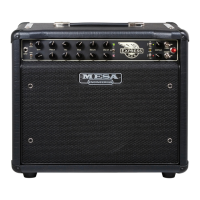PAGE 23
750 Hz is probably the most sonically powerful Band of the Graphic EQ’s five Bands. Not so much in its poten-
tial to cut toward the imbalanced or boost toward the unpleasant like the top of the 2200’s range, but rather
more in a musically active sense. It’s ability to scoop or boost radically the all-important midrange where guitar
lives in the frequency spectrum makes it the go-to for your most eective shaping for stylistic accuracy quickly.
This is especially true for jumping between old school blues and R&B sounds that are filled in with ample mid-
range, over to modern metal and Heavy styles where literally dropping the 750 can get you in the territory with
just this one Band’s setting. This is a bit of an overstatement, but it hints at the stylistically important power of
the 750 Hz Band.
Because of this shaping power and the importance of the midrange in the guitar’s makeup, as well as its place
in an ensemble landscape, this is a good time to recall the previously mentioned EQ Hangover we discussed
earlier. If there is any band among the five in the Graphic EQ that warps one’s tonal perspective the fastest, it is
750 Hz. Pulling out or boosting the midrange – at least on a guitar - of its character quickly and eectively and
then going back to a sound that replaces it with balance quickly, as can be the case when switching Channels
here in the MARK VII, can at times sound very strange while your ears adjust to the dierence.
On that note, when stylistically possible, try to avoid going down the rabbit hole in terms of the 750 Hz Slider.
The more you cut or boost the midrange, especially while also boosting the lows and highs alongside it with
adjacent Bands, the more dicult it will be to return to a balanced sound in the other Channels that may not
be engaging the same curve on the Graphic EQ. Over EQ’ing is rarely a good thing for Tone, so approach the
Graphic EQ as a tool for subtle enhancement, when possible, instead of a crutch the entire amp leans on …
unless you only need one color from its diverse palette.
2200 kHz handles the next higher region from the upper midrange through the middle top end. This is an
important frequency range as, like 750 Hz, it handles part of the spectrum that defines how a given sound will
cut through a mix. The 2200’s top end sits above the midrange, adding definition to the pick attack and, in a
way, places things in the time domain.
While cutting and boosting the 2200 kHz slider doesn’t change anything physically, it can seem as if it does, as
this lower top-end “cut” factor weighs heavily on how our ears perceive things in terms of a sound being slow
or fast feeling. Not just in the frequency range the 2200 controls but also in the low-end and lower midrange.
When dipping the 750 Hz Slider in search of width and dimension, you can boost the 2200 band and dial in
attack for the low end to give the impression of tightening it up. This can be especially eective for heavier,
higher gain sounds in Channels 2 and 3.
From that perspective, it is the 750 Hz and 2200 kHz Bands that are the most powerful and the most critical of
the five sliders to become familiar with and set appropriately for the sounds you want. Almost more than any
other, they determine how sounds feel to play and how authoritative or textural they will come across in a mix.
The 2200 Band is also an important bridge to the harmonic region found in the 6600 Band. Balancing these
two top-end sliders is very important, as 2200 provides the glue that holds a harmonically enhanced sound
together, at least in terms of rhythmic accuracy and overall definition. The more harmonics that are showcased
with the boosting - and sometimes even cutting – of the 6600 Band, the more critical the setting of the 2200
becomes in terms of filling in gaps and creating a sound that is cohesive, musical, and rhythmically accurate.
For example, when searching for huge-sounding yet tight-tracking Heavy sounds in Channels 2 and 3, try
working with and swapping the 2200 and 6600 to find the best blend of harmonic enhancement and definitive
pick attack. You may find the 2200 Band set a little higher than its higher 6600 kHz counterpart to add the cut
that keeps the low strings tracking their tightest and most accurately.
6600 kHz stands watch over the uppermost harmonic region, and though perhaps not as critical to the attack
frequencies, it is no less important to a balanced sound. Cutting or boosting 6600 to extremes can result in
either too dark or too bright a sound, from mued and choked to sizzling and thin, so you want to apply it with
taste and a musical sensibility.
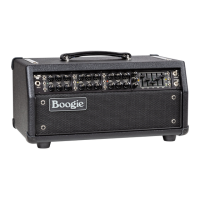
